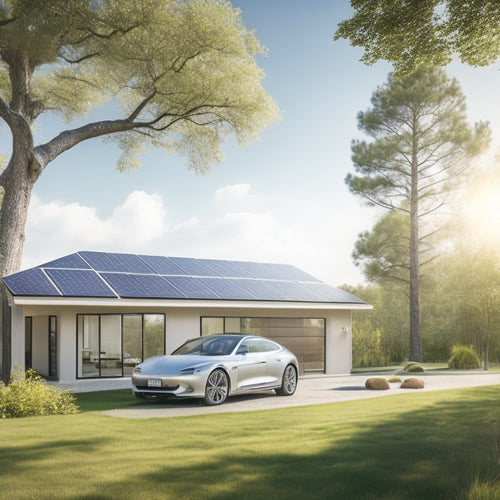
3 Essential Steps for Solar Power in Small Homes
Share
You'll want to tackle three essential steps to get solar power up and running in your small home. First, assess your energy needs by reviewing past electricity bills, calculating daily energy usage, and identifying areas of energy waste. Next, choose the right equipment by selecting high-efficiency solar panels, durable inverters, and ensuring compatibility with your roof. Finally, plan for installation by evaluating your roof's structural integrity, identifying potential shading issues, and estimating costs. By completing these initial steps, you'll be well on your way to utilizing the power of solar energy, and a smooth shift awaits with careful planning and execution.
Key Takeaways
- Review past electricity bills to identify energy consumption patterns and calculate total daily energy usage in watt-hours.
- Select high-efficiency solar panels and compatible inverters based on roof size, shape, and material to optimize energy production.
- Conduct a site evaluation to determine optimal panel placement, assess roof structural integrity, and identify potential shading issues.
- Research and hire a reputable installer for safe and compliant installation, considering factors like equipment, labor, permits, and inspections.
- Consider energy usage habits, including peak times and seasonal variations, to ensure a tailored solar power solution for small homes.
Assess Your Energy Needs
Before diving into solar power for your small home, evaluate your energy needs to determine how much power you require. This vital step helps you identify the right system size and configuration to meet your energy demands.
Start by reviewing your past electricity bills to understand your energy consumption patterns. Calculate your total daily energy usage in watt-hours (Wh) by multiplying the total kilowatt-hours (kWh) used per day by 1,000.
Next, conduct an efficiency evaluation of your home's energy usage. Identify areas of inefficiency, such as incandescent lighting or outdated appliances, and consider replacing them with energy-efficient alternatives. This will help reduce your overall energy consumption and optimize your solar power system's performance.
Additionally, consider your energy usage habits, such as peak usage times and seasonal variations, to guarantee your solar power system can meet your energy needs throughout the year.
Choose the Right Equipment
Selecting the right equipment for your solar power system is crucial to guarantee peak performance, efficiency, and cost-effectiveness.
You'll need to choose the right solar panel types, inverter, and other components to assure your system runs smoothly and efficiently.
When selecting solar panels, consider the following factors:
-
Efficiency: Look for panels with high efficiency ratings (above 20%) to maximize energy production.
-
Durability: Choose panels with a long warranty period (25 years or more) and a proven track record of withstanding harsh weather conditions.
-
Compatibility: Confirm the panels are compatible with your roof size, shape, and material.
For inverter selection, consider the type of inverter that suits your system: string inverters for traditional systems or microinverters for more complex installations.
Additionally, consider the inverter's efficiency, reliability, and compatibility with your solar panels.
Plan for Installation
With your equipment chosen, you're ready to plan for installation. This stage involves a thorough site evaluation to guarantee your solar panel system is installed efficiently and effectively.
You'll need to assess your roof's size, orientation, and structural integrity to determine the best placement of your panels. Additionally, consider any potential shading issues from trees, buildings, or other obstructions.
Next, you'll need to perform a cost estimation to determine the overall expense of the installation. This includes the cost of the equipment, labor, and any necessary permits or inspections.
Be sure to factor in any local incentives or rebates that may offset the upfront costs. A detailed cost estimation will help you budget accordingly and make any necessary adjustments to your installation plan.
During this stage, it's also crucial to research and hire a reputable installer who can guarantee a safe and compliant installation.
Frequently Asked Questions
Can I Install Solar Panels on My Own or Diy?
You can attempt a DIY solar panel installation, but it's essential to weigh the risks: improper installation can void warranties, compromise safety, and reduce efficiency. Consider hiring a professional to guarantee a seamless, code-compliant DIY solar system integration.
How Long Does a Solar Panel System Typically Last?
You'll be powered by the sun for decades, as the average solar panel lifespan is 30 years or more. Factors affecting longevity include quality, maintenance, and environmental conditions, but with proper care, you can maximize your system's lifespan.
Are There Any Maintenance Costs for Solar Panels?
You'll need to take into account maintenance costs for your solar panels, which include regular cleaning to guarantee ideal energy production, ideally every 6-12 months, depending on your location and climate, to minimize energy losses and maximize ROI.
Can I Sell Excess Energy Back to the Grid?
You're probably generating more energy than you need, but don't worry, you won't be stuck with it. Through net metering benefits and energy buyback programs, you can sell excess energy back to the grid and reap the financial rewards, offsetting your initial investment.
Are Solar Panels Environmentally Friendly and Sustainable?
You'll find that solar panels are environmentally friendly and sustainable, offering significant solar energy benefits, as they utilize renewable energy, reducing your carbon footprint and mitigating the negative impact of traditional energy sources on the environment.
Related Posts
-

Why You Need a Phone Mount for Navigation
When you're on the road, a reliable phone mount is not just a convenience, it's a safety necessity that helps you mai...
-

Why Invest in Solar Car Battery Chargers Online?
By investing in a solar car battery charger online, you're not only reducing your reliance on fossil fuels but also o...
-

Why Cities Need Smart Charging Infrastructure Now
You're about to experience a tidal wave of electric vehicles hitting your city's streets, and it's essential you're p...


